Christmas Trees, Caves and Cribbage.
The strange connections between the game of Cribbage, a bronze age boardgame carved in a cave and the first artificial Christmas trees in Babylonian temples.
“In the woods there grew a tree and a fine tree was he..”
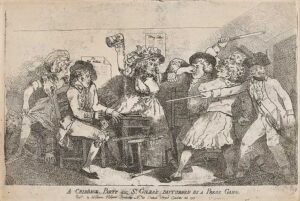
Cribbage Party
Crib is an odd game of weird rules and counting systems, it is also one of the rare times you can say ‘one for his nob’ in polite company. But where did it come from?
On the face of it Cribbage is a few hundred years old, possibly having been invented by poet and gambler John Suckling in the 17th century as a version of an older game called Noddy.
Crib’s odd counting system has special significance for 5s, 15 and 31 which was similar to Noddy. Some modern Crib boards tend to end after 121 holes/points per player but earlier versions had 61: two rows of 30, separated into fives, plus one at the top. It seems quite possible Noddy boards had 30 each with 1 at the top, the winning hole.
The earliest record of Noddy so far found seems to be only the 16th century but if you look at the Crib board shape, the use of marker pegs and the amount of peg holes it bears a striking similarity to the board used for a game played throughout most of the bronze age from Mesopotamia to Egypt.
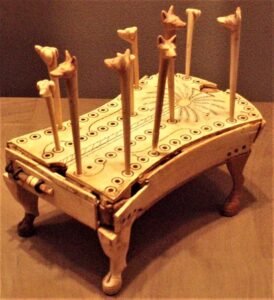
Hounds & Jackals Thebes 1800BCE (Met)
Called 58 holes or hounds and jackals (because some of the pegs are made in their shape) it seems to have been played for over a thousand years, from at least 2200 to 700 BCE, and in 2018 Walter Crist, from the American Museum of Natural History in New York, was even shown one scratched on the ground of a cave in Azerbaijan dating back to 2000 BCE.
But is it even a game? It actually has 59 holes: 29 each side the same as a full phase of the moon and an extra ‘winning’ hole. From new moon to new moon is more accurately about 29.5 days so 59 holes is exactly double this. Every 5th hole there is a special mark (again like Crib). Was it initially used to tally or record the moon’s phase? If it was a game was it at least based on the moon’s phases, or a mixture of religion come game board? There is a tendency to see everything ancient as religious but other games such as snakes and ladders can be linked to games in India where you ascend enlightenment to Heaven. If you look at the image on a hounds and jackals board now in the Met Museum it has tantalising echoes of snakes and ladders with lines between some of the holes.
“In Eridu a tree grew overshadowing; in a holy place did it become green; Its roots were of white crystal, which stretched towards the deep.”
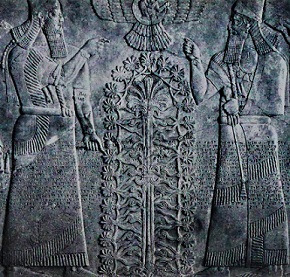
Assyrian Sacred Tree 860 BCE (Br Museum)
The snakes and ladders connection might be an unlikely distant cousin but there is another ancient image which seems to look much more like it is part of the Crib/Noddy/Jackals family: The Sacred Tree. If you compare the Met Museum Hounds and Jackals game image with the British Museum Assyrian sacred tree image (from 865-860 BC) there are some striking similarities: The game has a tree inside an arc whose holes number 58 (two sets of 29). The sacred tree carving is inside an arc of flowers, those flowers numbering 29. There are also stems coming from the outside arc to the central trunk. This could seem like a stretch but the game and tree could both be stylised versions of the same idea.
The stems and stylisation of the tree itself can be seen even more clearly in the next image. This tree has only 15 flowers not 29 but is as close to half of 29.5 as you can get. This tree looks artificial and so they were. Archaeological discoveries going back to the 19th century revealed bronze and gold bark and bronze leaves and branches that would have been attached to cedar tree posts and so assembled as sacred trees and placed at temple entrances and doorways. As well as the archaeology there are also records on a clay prism of palm trees made of bronze in Sumeria from 1900BCE. They were pretty much like today's shiny fake Christmas trees you pull down out of the loft each year to put together over a mince pie, mulled wine and mild swearing. (If you want to stretch the analogy further look at the main image again: you can even see a winged ‘fairy’ on top and in other pictures, of which I can only find poor images from cylindrical seals, the top is like a star).
“.. the tree which is in the midst of the garden…the day ye eat thereof, then your eyes shall be opened, and ye shall be as gods..”
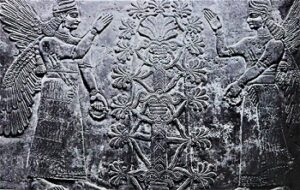
Angels and 15 flowers
In written records from about the 6th century BCE a prophet called Ezekiel, while in Babylon, mentions a dream where a god tells him how to build a temple: “And the temple and the sanctuary had two doors…made so that a palm tree was between a cherub and a cherub (this is just before the god tells Ezekiel he wants a week-long slaughter of goats, bulls and sheep with ‘the blood thereof’ scattered round the altar and the dead animals burnt as a ‘sin offering’)
That dream was part of a temple Ezekiel hoped to build in Jerusalem to mimic the one Solomon was supposed to have built: “And he carved thereon cherubims and palm trees and open flowers.” The older Akkadian temples, where these artificial trees were often found in bits or in carvings, were temples to their God of the Moon: Sin/Nanna, main god of Ur and ‘father of all gods’.
We have then: Crib boards that look like Hounds and Jackals boards that look like sacred artificial trees at the temples of the moon god, the moon that has a 29 day phase like each player’s places in the Hounds and Jackals game.
So if you want to enjoy a traditional Christmas this year put up your fake tree, cover it in shiny things and sit underneath it playing Crib while worshipping the moon. You don’t even have to have a crib board, just roll up the carpet and scratch the outline on the floor like they did 4000 years ago.
With the money saved you can buy a copy of Fries to read, I hear it is quite good.
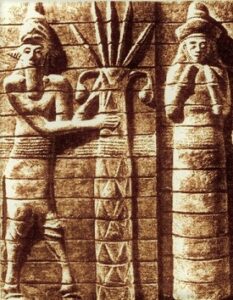
12th century BCE Susa (Louvre)
(In the interest of facts in should be pointed out this is a speculative and whimsical ramble: a number of hounds and jackals boards do not have a tree in the centre or a lovely arc shape and there are many Assyrian sacred tree images which do not have 29 or 15 flowers on them. And yet.. the similarity in the images that do match might have a common reason if only asthetics, the use of trees in temples is a fascinating subject I hope to come back to in a later post, the moon link is interesting and I probably will play Crib at Christmas under a shiny Christmas tree.)
In the Susa/Louvre image you can clearly see a person very happy to see the tree being set up for another year even if the amount of baubles on it so far is a poor effort.
For further reading on Noddy, the distribution of fifty-eight holes (hounds and jackals), a detailed look at the arguements over Assyrian artificial trees and a collection of old seals...
https://www.parlettgames.uk/histocs/noddy.html
Cultural transmission in the ancient Near East: twenty squares and fifty-eight holes. Alex de Voogt, Anne-Elizabeth Dunn-Vaturi, Jelmer W. Eerkens. Journal of Archaeological Science 40.4 (2013)
The Assyrian sacred tree: A history of interpretations. M Giovino. Orbis biblicus et orientalis.(2007)
Ancient oriental seals in the collection of Mrs. Agnes Baldwin Brett. A. Baldwin Brett, H. Henning von der Osten. University of Chicago Press. (1936).
Merry Christmas!

Neo Babylonian seal 600BCE